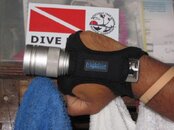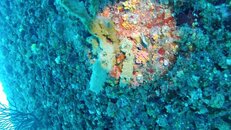Lights are really good if you need to film something within 10 feet of you. After that your lights become very quickly ineffective. Having said that if all you do is macro shoot then by all means go out and buy lights. I do not have lights... all I have is a red lens filter and dive 8am-1pm. By time boat leaves, gets to dive spot, you jump, get situated, come back up, do your surface interval etc etc etc... You get both of your dives from 9-10 and 11-12. Needless to say if you dive at night you will need lights. My bigblue cf250 x 2 work within 10 feet on night dives, after that while I can see the light camera says.... pfft what's that and you get nothing but a mostly black diluted image.
A dive light let's say 1500 lumens will work like a charm, better yet 2 will work even better but again you have to realize what it is that you will be filming.
Perfect example... out of all the times I dove in Cozumel... I never had to use lights and I dove 45-90ft. Granted I was not able to film the swim through but 3 seconds of swimming is honestly not worth 3000 dollars worth of lights and more importantly if you (like me) never have the need for lights then it would be really really silly to buy them and use them once in a blue moon.
My camera is bonica hddv. My recent additions to dive setup are 2 gopro hero 3 black. I used to have my flashlights mounted to the tray and I just took them down to replace them with gopro setup.
I do, however have 2 err. what are they called... tactical glove thingies which let me attach flashlights and I will continue diving in that formation like so:

But even then I am doing so only because I always dive with flashlights regardless.
It is not easy filming something dark and that is why dive lights are recommended but sometimes you need to be able to justify that purchase. After filming since 2008 I think there was only one time where I really wish I had dive lights and that is only because we did a night shore dive in Cozumel and I did not take my camera with me but had my big blue flashlights shining the way... that is until a diver with a budget 20 times the size of mine pulled out his fancy canister light system which made my led lights feel like a candle.
Check out my signature and visit my youtube channel. I do not post many videos online but those you see on channel were filmed in green water, blue water, 45-90ft deep, cloudy days, bad vis days, filming walls, filming crevises etc etc... pretty much all the things O.P. has concerns about. for a sub $500 camera with no lights... not too shabby.





